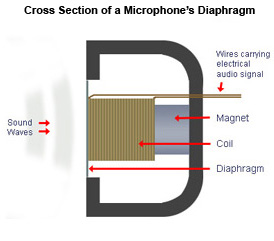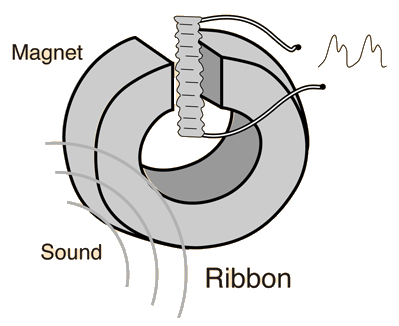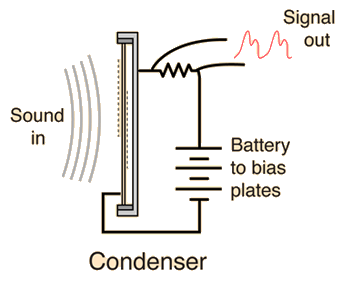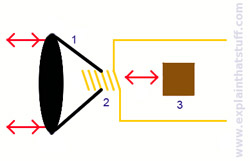Transducers
Claimed by Derin Ozturk (dozturk7) --Dozturk7 (talk) 22:09, 2 December 2015 (EST)
Transducers are devices that convert one form of energy to another. This topic will explain what transducers are, specifically bidirectional transducers, and their applications.
The Main Idea
A transducer, in general, is any device that converts one form energy to another. Usually this is some signal in one form of energy that is converted to signal in a different form of energy. There are many types of transducers, and the topic does incorporate many different concepts from physics and spans many fields, so this page will be only focusing on one type of transducers, bidirectional transducers, and two important applications: microphones and loudspeakers.
Bidirectional Transducers
In short, a bidirectional, or sometimes also called bilateral transducer, is a transducer that can convert some form energy from to another, such as an electric signal to an acoustical signal, but can also convert the other way, such as an acoustical signal to an electrical signal. Hence the name bidirectional.
Sound, Microphones, and Loudspeakers
A Brief Recap of Sound
Sound is a wave, that travels through a medium (usually the air, but it can also be any material such as water or steel) as a disturbance in that medium. This wave transports energy from one location to another location, originating from the vibration of an object or particles that causes the disturbance in the medium. Because there is particle to particle interaction, sound is considered a mechanical wave. As a wave, sound has a frequency (sound is usually measure in Hertz, where 1 Hz is equal to 1 vibration per a second). The sensation caused by the frequency in sound is called pitch. A low frequency corresponds with low pitch and a high frequency corresponds with a high pitch.
 Sound, portrayed as a longitudinal wave.
Sound, portrayed as a longitudinal wave.
Microphones
A microphone is simply a transducer which detects sound signals and produces electrical "images" of this sound. This image can be a voltage or current. These images are proportional to the sound signal.
There are several different types of microphones. The most common are dynamic microphones, ribbon microphones, and condenser microphones.
Dynamic Microphones
The diagram above shows the inside configuration of a dynamic microphone. Sound enters into the cone of the microphone where it causes a diaphragm to vibrate. As the diaphragm vibrates, the coil that is attached to the diaphragm vibrates as well (this is proportional to the frequency at which the diaphragm vibrates!). The movement of the coil causes an induced changing current in the coil due to the magnet (remember Faraday's law). A dynamic microphone can simply be thought of as the inverse of a loudspeaker (see loudspeaker for more information).
Ribbon Microphones
A ribbon microphone is very similar to a dynamic microphone in that the principle of transforming the energy from the sound wave to an electric image is caused by a change in the position a conducting metal within a magnetic field.
This type of microphone, as shown in the diagram above, is made of a circular magnet, in which a "ribbon" of conducting metal lies between it. Sound waves cause a disturbance in the air that moves this ribbon. The ribbon moves, causing an induced voltage due to the generator effect (see Faraday's law), whereas this voltage is proportional to the velocity the ribbon experiences.
Condenser Microphones
A condenser microphone is different from a dynamic and ribbon microphone in that it relies on a capacitor to create a changing voltage. This capacitor, as shown above, is made of a back plate that is fixed in place and has a fixed current, and a front plate that is a thin metallic membrane. This membrane vibrates when sound waves hit it. Because the membrane is oscillating side to side, the distance between the back plate and the membrane changes, thus causing a changing voltage.
Loudspeakers
An electric image from one of the three microphones above, or any other type of microphone not mentioned above can be reconverted back to an acoustic sound wave through the use of a loudspeaker.
Loudspeakers, or speakers for short, have three main components inside of them that help convert a varying voltage (or current) from an audio source, such as microphone. These three components are: a cone, a electromagnet (coil), and a permanent magnet. The electromagnet is similar to a permanent magnet, however, when an electric current flows through it, it creates a magnetic field. As seen in the diagram above, the electromagnet is placed in front of the permanent magnet, which is fixed into position. The electromagnet is free to move. As an alternating current (maybe from a microphone as explained above) passes through this electromagnet, the magnetic field made by the electromagnet changes. It begins to attract and repel to the permanent magnet as the current changes. This vibration causes the cone, which is usually made of a paper or plastic (light materials), to vibrate as well. The vibrations of the cone are amplified because of their size. These vibration push the air, thus creating sound. This current is proportional to the sound frequencies that were passed through by the microphone so the sound that is emitted by the cone is the "same."
The sound outputted by the speaker can be distorted. This is why higher fidelity speakers will use different sized speakers (like subwoofers and tweeters) that are dedicated to only reproducing low and high frequencies.
Connectedness
- How is this topic connected to something that you are interested in?
I consider myself to be an audiophile, so I thought it would be really interesting to learn what goes into making speakers and other similar electronics.
- How is it connected to your major?
I'm majoring in Computer Engineering. This field covers both the hardware and software side of electronics. Transducers are an important piece of hardware in todays electronics.
- Is there an interesting industrial application?
Speakers, microphones, headphones, antenna, accelerometers, etc.
History
Transduction was observed back in ancient times when Theophrastus noticed that a gem stone would become charged when heated. This phenomenon is called pyroelectricity, which is the ability for certain materials to generate a voltage when heated up or cooled down. Transducing materials that could transduce both electric and magnetic fields were discovered in the 1800's. James Joule discovered "Joule magnetostriction" in 1842, which describes how a bar of iron constricts under the influence of a magnetic field. The Curie brothers also discovered how to create an electric charge by applying mechanical forces to quartz. This phenomenon is called piezoelectricity. During World War II, nickel was a commonly used transduction material. Transducers allowed for the invention of sonar devices that would provide to be very beneficial during the war.
Today, all types of audio devices use piezo crystals (crystals that have piezoelectric properties), and transducers have many applications in every day electronics such as antennae, microphones, speakers, accelerometers, and pH meters.
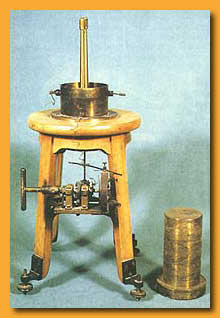 The Curie's piezo electrometer.
The Curie's piezo electrometer.
See also
Are there related topics or categories in this wiki resource for the curious reader to explore? How does this topic fit into that context?
Faraday's Law
Capacitors
Sound
References
This section contains the the references you used while writing this page
http://www.fishhunter.com/history-of-transducers/
http://www.azom.com/article.aspx?ArticleID=1376
http://hyperphysics.phy-astr.gsu.edu/hbase/sound/soucon.html
